Abstract
An anti-tumour agent 5,6-dimethylxanthenone-4-acetic acid (5,6-MeXAA) induced nitric oxide synthase (NOS) in the tumour, spleen, thymus and small intestine, but not in the lung, liver, kidney, heart or skeletal muscle in B6D2F1 mice bearing subcutaneous colon 38 tumours. This pattern of induction is distinct from that caused by agents such as endotoxin, muramyl dipeptide or Corynebacterium parvum. The induction of NOS (iNOS) in the tumour was more persistent (maximal at 3 days) than in other tissues (maximal at 12 h). Immunohistochemical staining suggested that iNOS was located in macrophages and endothelial cells within and around the tumour. Treatment with 5,6-MeXAA also caused substantial increases in plasma nitrite and nitrate (NOx) concentrations that peaked at 8-12 h after 5,6-MeXAA. The increase in plasma NOx was prevented by a NOS inhibitor N-iminoethyl-L-ornithine (L-NIO), indicating that it was due to enhanced production of NO. Tumour-bearing mice were more responsive than controls to 5,6-MeXAA both in their plasma NOx increase and in their lower maximally tolerated dose. L-NIO was unable to prevent the complete tumour necrosis and regression caused by 5,6-MeXAA at a dose that substantially inhibited the increase of plasma NOx. In conclusion, the experimental anti-tumour agent 5,6-MeXAA induced NO synthesis in tumour-associated macrophages and in immunologically active tissues in parallel with its effects on tumour growth. The experiments with a non-selective NOS inhibitor L-NIO, however, suggest that NO is not a significant component in the mechanism of the anti-tumour action of 5,6-MeXAA in this particular model.
Full text
PDF
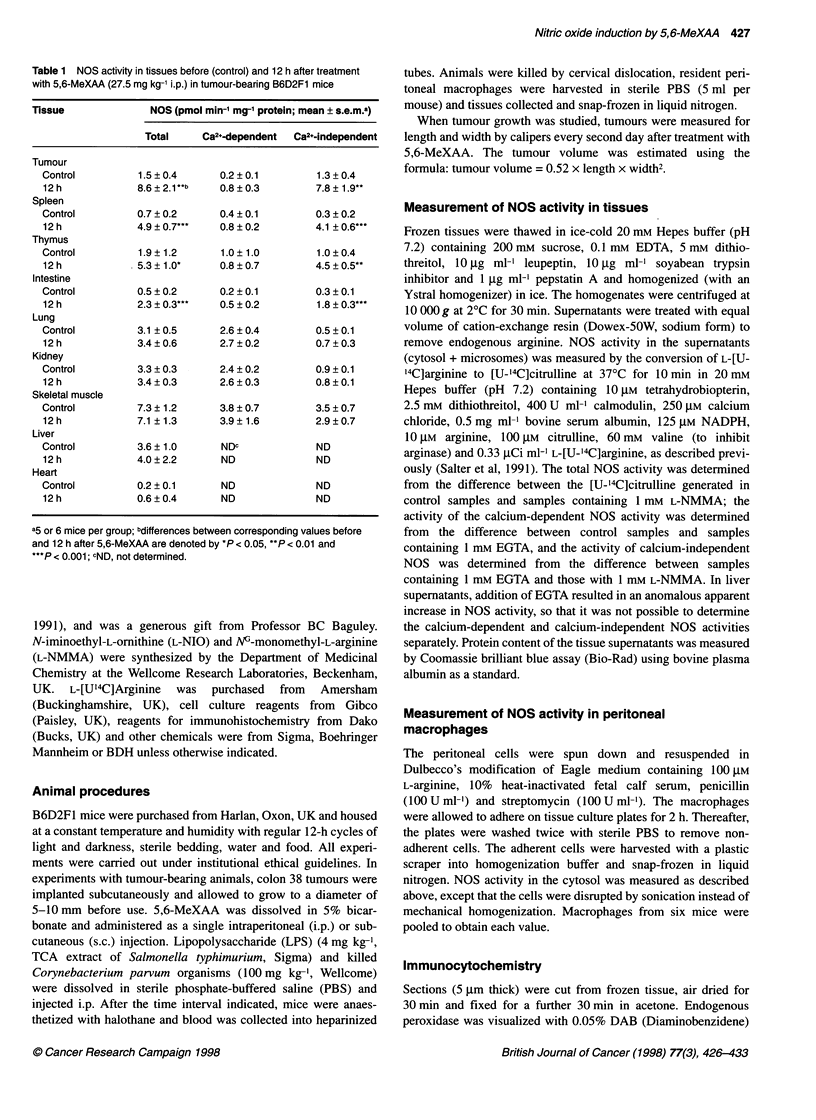
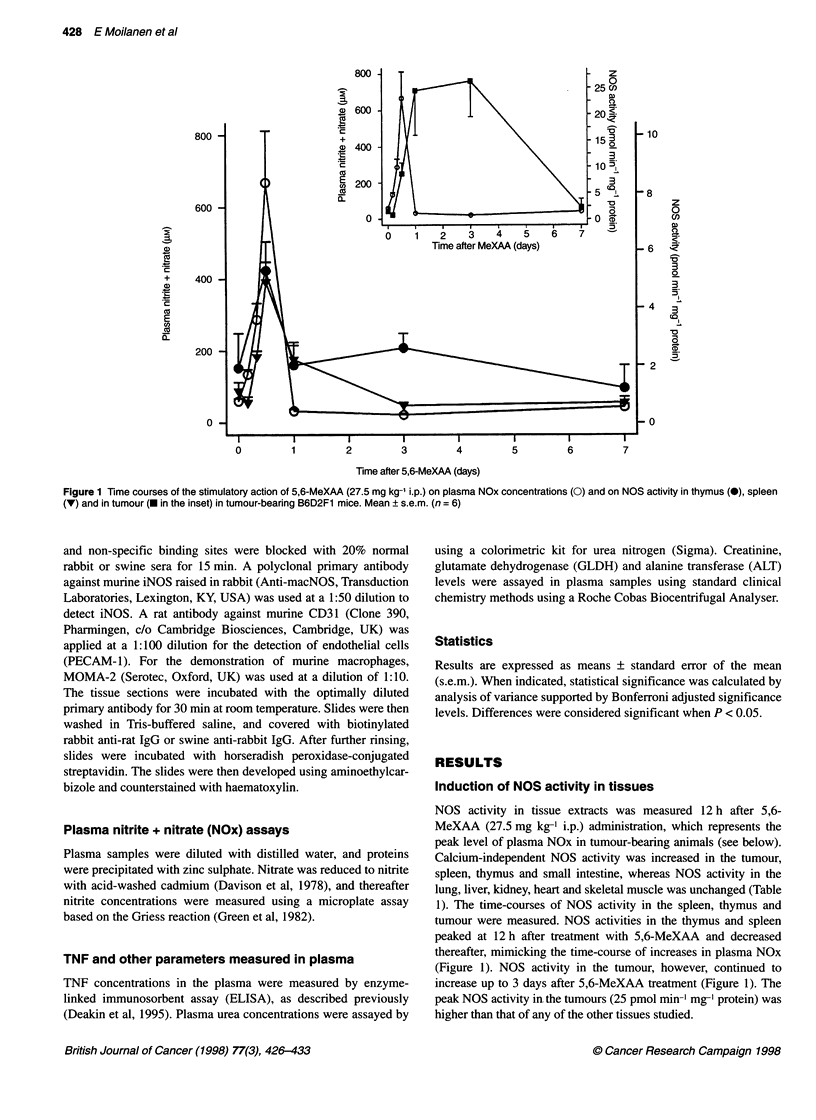
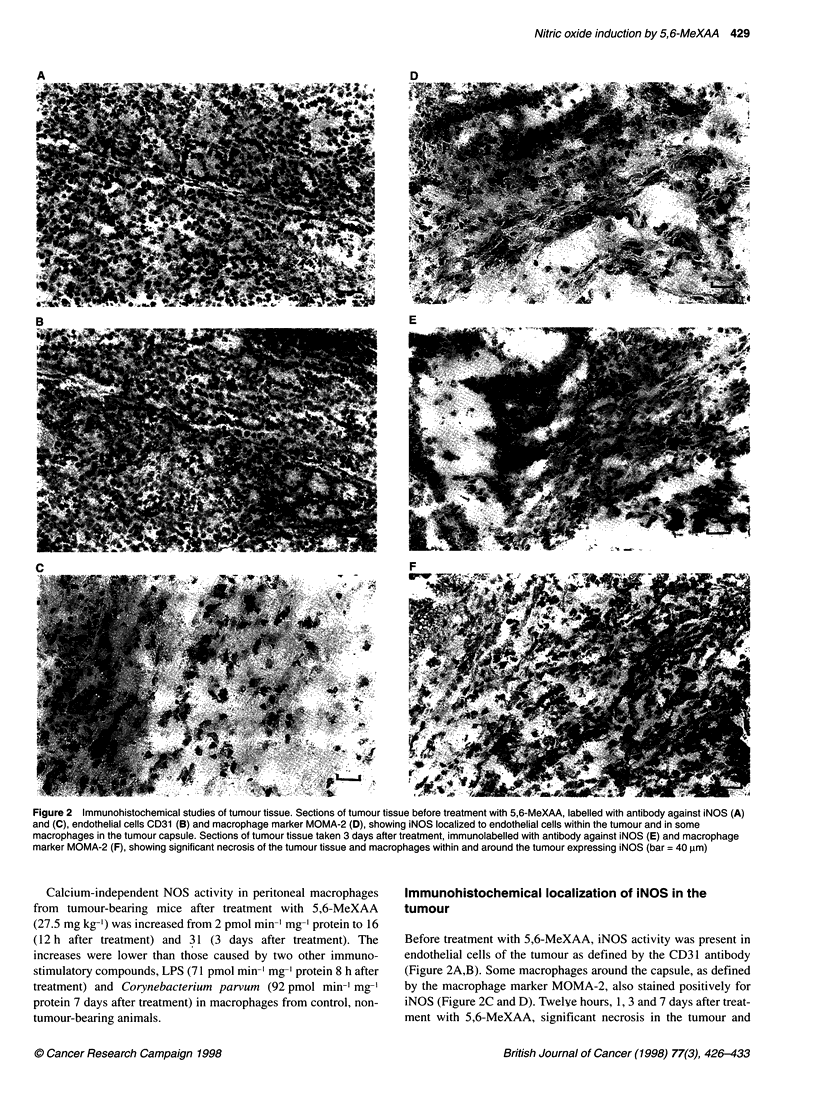
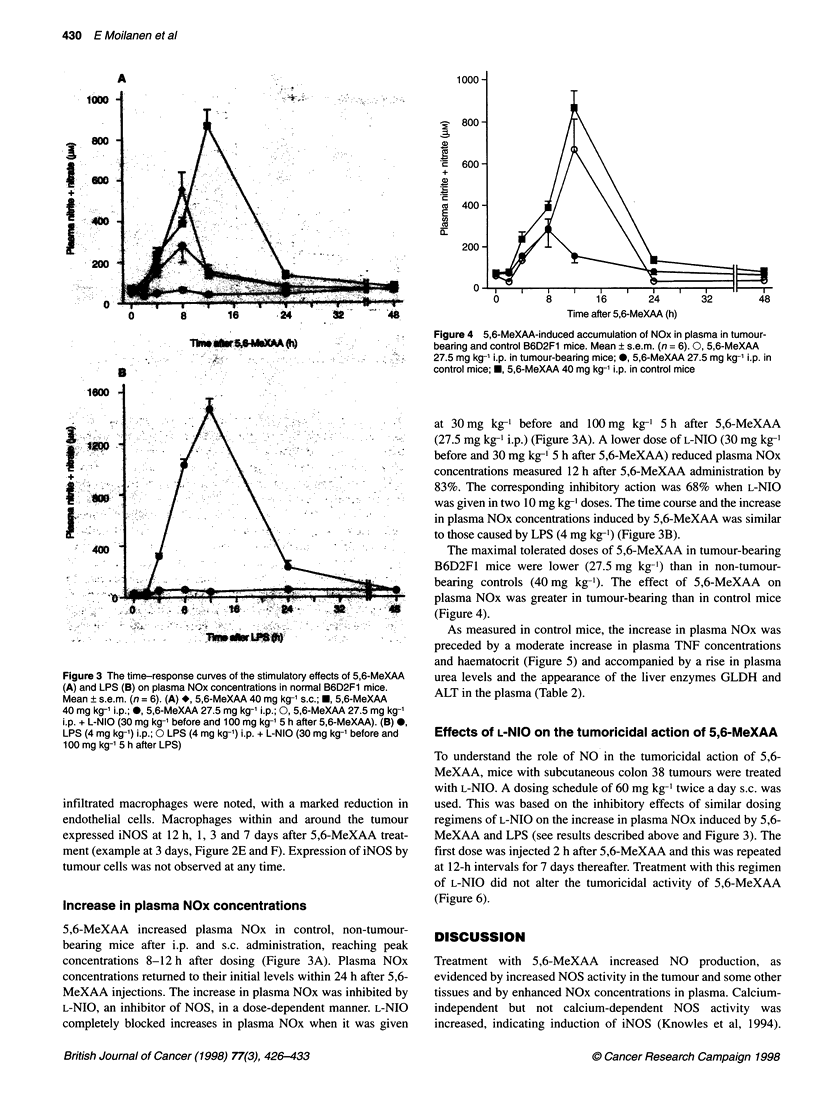

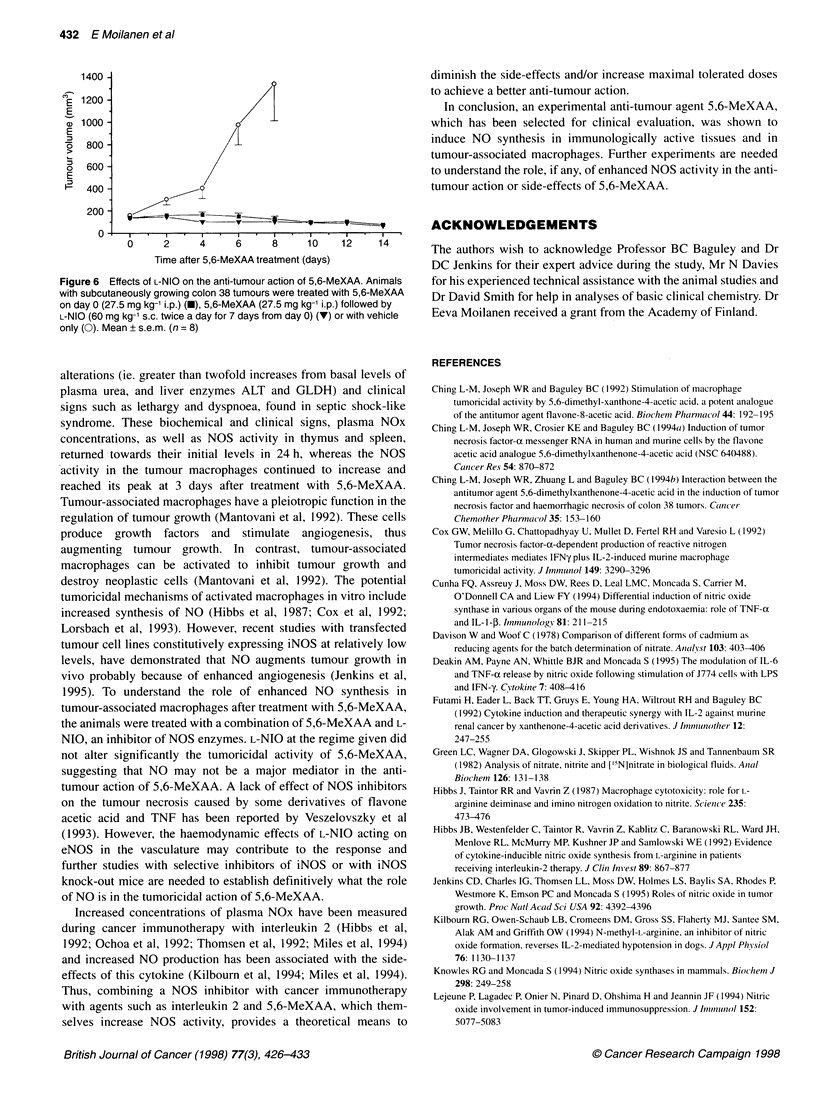
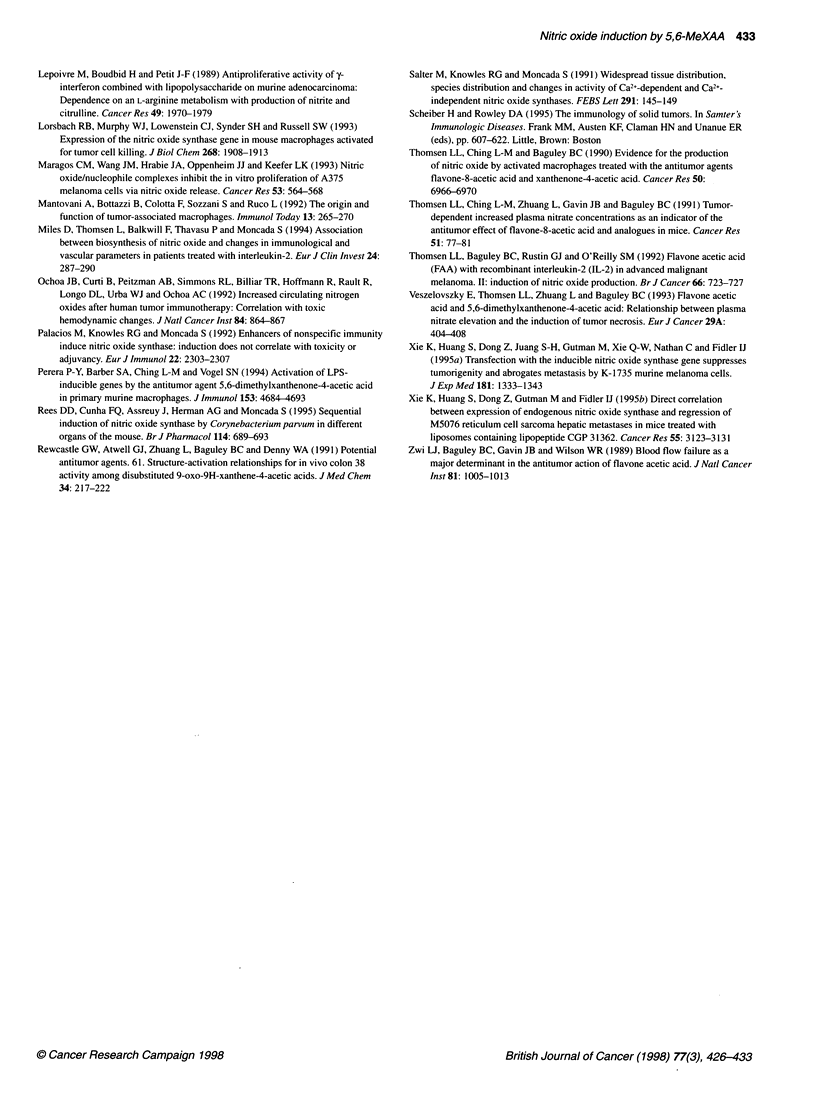
Images in this article
Selected References
These references are in PubMed. This may not be the complete list of references from this article.
- Ching L. M., Joseph W. R., Baguley B. C. Stimulation of macrophage tumouricidal activity by 5,6-dimethyl-xanthenone-4-acetic acid, a potent analogue of the antitumour agent flavone-8-acetic acid. Biochem Pharmacol. 1992 Jul 7;44(1):192–195. doi: 10.1016/0006-2952(92)90058-q. [DOI] [PubMed] [Google Scholar]
- Ching L. M., Joseph W. R., Crosier K. E., Baguley B. C. Induction of tumor necrosis factor-alpha messenger RNA in human and murine cells by the flavone acetic acid analogue 5,6-dimethylxanthenone-4-acetic acid (NSC 640488). Cancer Res. 1994 Feb 15;54(4):870–872. [PubMed] [Google Scholar]
- Ching L. M., Joseph W. R., Zhuang L., Baguley B. C. Interaction between endotoxin and the antitumour agent 5,6-dimethylxanthenone-4-acetic acid in the induction of tumour necrosis factor and haemorrhagic necrosis of colon 38 tumours. Cancer Chemother Pharmacol. 1994;35(2):153–160. doi: 10.1007/BF00686639. [DOI] [PubMed] [Google Scholar]
- Cox G. W., Melillo G., Chattopadhyay U., Mullet D., Fertel R. H., Varesio L. Tumor necrosis factor-alpha-dependent production of reactive nitrogen intermediates mediates IFN-gamma plus IL-2-induced murine macrophage tumoricidal activity. J Immunol. 1992 Nov 15;149(10):3290–3296. [PubMed] [Google Scholar]
- Cunha F. Q., Assreuy J., Moss D. W., Rees D., Leal L. M., Moncada S., Carrier M., O'Donnell C. A., Liew F. Y. Differential induction of nitric oxide synthase in various organs of the mouse during endotoxaemia: role of TNF-alpha and IL-1-beta. Immunology. 1994 Feb;81(2):211–215. [PMC free article] [PubMed] [Google Scholar]
- Deakin A. M., Payne A. N., Whittle B. J., Moncada S. The modulation of IL-6 and TNF-alpha release by nitric oxide following stimulation of J774 cells with LPS and IFN-gamma. Cytokine. 1995 Jul;7(5):408–416. doi: 10.1006/cyto.1995.0056. [DOI] [PubMed] [Google Scholar]
- Futami H., Eader L., Back T. T., Gruys E., Young H. A., Wiltrout R. H., Baguley B. C. Cytokine induction and therapeutic synergy with interleukin-2 against murine renal and colon cancers by xanthenone-4-acetic acid derivatives. J Immunother (1991) 1992 Nov;12(4):247–255. doi: 10.1097/00002371-199211000-00005. [DOI] [PubMed] [Google Scholar]
- Green L. C., Wagner D. A., Glogowski J., Skipper P. L., Wishnok J. S., Tannenbaum S. R. Analysis of nitrate, nitrite, and [15N]nitrate in biological fluids. Anal Biochem. 1982 Oct;126(1):131–138. doi: 10.1016/0003-2697(82)90118-x. [DOI] [PubMed] [Google Scholar]
- Hibbs J. B., Jr, Taintor R. R., Vavrin Z. Macrophage cytotoxicity: role for L-arginine deiminase and imino nitrogen oxidation to nitrite. Science. 1987 Jan 23;235(4787):473–476. doi: 10.1126/science.2432665. [DOI] [PubMed] [Google Scholar]
- Hibbs J. B., Jr, Westenfelder C., Taintor R., Vavrin Z., Kablitz C., Baranowski R. L., Ward J. H., Menlove R. L., McMurry M. P., Kushner J. P. Evidence for cytokine-inducible nitric oxide synthesis from L-arginine in patients receiving interleukin-2 therapy. J Clin Invest. 1992 Mar;89(3):867–877. doi: 10.1172/JCI115666. [DOI] [PMC free article] [PubMed] [Google Scholar]
- Jenkins D. C., Charles I. G., Thomsen L. L., Moss D. W., Holmes L. S., Baylis S. A., Rhodes P., Westmore K., Emson P. C., Moncada S. Roles of nitric oxide in tumor growth. Proc Natl Acad Sci U S A. 1995 May 9;92(10):4392–4396. doi: 10.1073/pnas.92.10.4392. [DOI] [PMC free article] [PubMed] [Google Scholar]
- Kilbourn R. G., Owen-Schaub L. B., Cromeens D. M., Gross S. S., Flaherty M. J., Santee S. M., Alak A. M., Griffith O. W. NG-methyl-L-arginine, an inhibitor of nitric oxide formation, reverses IL-2-mediated hypotension in dogs. J Appl Physiol (1985) 1994 Mar;76(3):1130–1137. doi: 10.1152/jappl.1994.76.3.1130. [DOI] [PubMed] [Google Scholar]
- Knowles R. G., Moncada S. Nitric oxide synthases in mammals. Biochem J. 1994 Mar 1;298(Pt 2):249–258. doi: 10.1042/bj2980249. [DOI] [PMC free article] [PubMed] [Google Scholar]
- Lejeune P., Lagadec P., Onier N., Pinard D., Ohshima H., Jeannin J. F. Nitric oxide involvement in tumor-induced immunosuppression. J Immunol. 1994 May 15;152(10):5077–5083. [PubMed] [Google Scholar]
- Lepoivre M., Boudbid H., Petit J. F. Antiproliferative activity of gamma-interferon combined with lipopolysaccharide on murine adenocarcinoma: dependence on an L-arginine metabolism with production of nitrite and citrulline. Cancer Res. 1989 Apr 15;49(8):1970–1976. [PubMed] [Google Scholar]
- Lorsbach R. B., Murphy W. J., Lowenstein C. J., Snyder S. H., Russell S. W. Expression of the nitric oxide synthase gene in mouse macrophages activated for tumor cell killing. Molecular basis for the synergy between interferon-gamma and lipopolysaccharide. J Biol Chem. 1993 Jan 25;268(3):1908–1913. [PubMed] [Google Scholar]
- Mantovani A., Bottazzi B., Colotta F., Sozzani S., Ruco L. The origin and function of tumor-associated macrophages. Immunol Today. 1992 Jul;13(7):265–270. doi: 10.1016/0167-5699(92)90008-U. [DOI] [PubMed] [Google Scholar]
- Maragos C. M., Wang J. M., Hrabie J. A., Oppenheim J. J., Keefer L. K. Nitric oxide/nucleophile complexes inhibit the in vitro proliferation of A375 melanoma cells via nitric oxide release. Cancer Res. 1993 Feb 1;53(3):564–568. [PubMed] [Google Scholar]
- Miles D., Thomsen L., Balkwill F., Thavasu P., Moncada S. Association between biosynthesis of nitric oxide and changes in immunological and vascular parameters in patients treated with interleukin-2. Eur J Clin Invest. 1994 Apr;24(4):287–290. doi: 10.1111/j.1365-2362.1994.tb01087.x. [DOI] [PubMed] [Google Scholar]
- Ochoa J. B., Curti B., Peitzman A. B., Simmons R. L., Billiar T. R., Hoffman R., Rault R., Longo D. L., Urba W. J., Ochoa A. C. Increased circulating nitrogen oxides after human tumor immunotherapy: correlation with toxic hemodynamic changes. J Natl Cancer Inst. 1992 Jun 3;84(11):864–867. doi: 10.1093/jnci/84.11.864. [DOI] [PubMed] [Google Scholar]
- Palacios M., Knowles R. G., Moncada S. Enhancers of nonspecific immunity induce nitric oxide synthase: induction does not correlate with toxicity or adjuvancy. Eur J Immunol. 1992 Sep;22(9):2303–2307. doi: 10.1002/eji.1830220919. [DOI] [PubMed] [Google Scholar]
- Perera P. Y., Barber S. A., Ching L. M., Vogel S. N. Activation of LPS-inducible genes by the antitumor agent 5,6-dimethylxanthenone-4-acetic acid in primary murine macrophages. Dissection of signaling pathways leading to gene induction and tyrosine phosphorylation. J Immunol. 1994 Nov 15;153(10):4684–4693. [PubMed] [Google Scholar]
- Rees D. D., Cunha F. Q., Assreuy J., Herman A. G., Moncada S. Sequential induction of nitric oxide synthase by Corynebacterium parvum in different organs of the mouse. Br J Pharmacol. 1995 Feb;114(3):689–693. doi: 10.1111/j.1476-5381.1995.tb17193.x. [DOI] [PMC free article] [PubMed] [Google Scholar]
- Rewcastle G. W., Atwell G. J., Li Z. A., Baguley B. C., Denny W. A. Potential antitumor agents. 61. Structure-activity relationships for in vivo colon 38 activity among disubstituted 9-oxo-9H-xanthene-4-acetic acids. J Med Chem. 1991 Jan;34(1):217–222. doi: 10.1021/jm00105a034. [DOI] [PubMed] [Google Scholar]
- Salter M., Knowles R. G., Moncada S. Widespread tissue distribution, species distribution and changes in activity of Ca(2+)-dependent and Ca(2+)-independent nitric oxide synthases. FEBS Lett. 1991 Oct 7;291(1):145–149. doi: 10.1016/0014-5793(91)81123-p. [DOI] [PubMed] [Google Scholar]
- Thomsen L. L., Baguley B. C., Rustin G. J., O'Reilly S. M. Flavone acetic acid (FAA) with recombinant interleukin-2 (TIL-2) in advanced malignant melanoma. II: Induction of nitric oxide production. Br J Cancer. 1992 Oct;66(4):723–727. doi: 10.1038/bjc.1992.346. [DOI] [PMC free article] [PubMed] [Google Scholar]
- Thomsen L. L., Ching L. M., Baguley B. C. Evidence for the production of nitric oxide by activated macrophages treated with the antitumor agents flavone-8-acetic acid and xanthenone-4-acetic acid. Cancer Res. 1990 Nov 1;50(21):6966–6970. [PubMed] [Google Scholar]
- Thomsen L. L., Ching L. M., Zhuang L., Gavin J. B., Baguley B. C. Tumor-dependent increased plasma nitrate concentrations as an indication of the antitumor effect of flavone-8-acetic acid and analogues in mice. Cancer Res. 1991 Jan 1;51(1):77–81. [PubMed] [Google Scholar]
- Veszelovszky E., Thomsen L. L., Li Z., Baguley B. C. Flavone acetic acid and 5,6-dimethylxanthenone-4-acetic acid: relationship between plasma nitrate elevation and the induction of tumour necrosis. Eur J Cancer. 1993;29A(3):404–408. doi: 10.1016/0959-8049(93)90396-w. [DOI] [PubMed] [Google Scholar]
- Xie K., Huang S., Dong Z., Gutman M., Fidler I. J. Direct correlation between expression of endogenous inducible nitric oxide synthase and regression of M5076 reticulum cell sarcoma hepatic metastases in mice treated with liposomes containing lipopeptide CGP 31362. Cancer Res. 1995 Jul 15;55(14):3123–3131. [PubMed] [Google Scholar]
- Xie K., Huang S., Dong Z., Juang S. H., Gutman M., Xie Q. W., Nathan C., Fidler I. J. Transfection with the inducible nitric oxide synthase gene suppresses tumorigenicity and abrogates metastasis by K-1735 murine melanoma cells. J Exp Med. 1995 Apr 1;181(4):1333–1343. doi: 10.1084/jem.181.4.1333. [DOI] [PMC free article] [PubMed] [Google Scholar]
- Zwi L. J., Baguley B. C., Gavin J. B., Wilson W. R. Blood flow failure as a major determinant in the antitumor action of flavone acetic acid. J Natl Cancer Inst. 1989 Jul 5;81(13):1005–1013. doi: 10.1093/jnci/81.13.1005. [DOI] [PubMed] [Google Scholar]



